In our previous post, we presented a new measure of first-time homebuyers. In this post, we use this improved measure to describe the characteristics of first-time buyers and how those characteristics change over time. Having an accurate assessment of first-time buyers is important given that the aim of many housing policies is to support the transition from renting to owning. A proper assessment of these housing policies requires an understanding of the impact of these policies on the share of first-time buyers and the characteristics of these buyers. Our third post will directly examine the sustainability of homeownership by first-time buyers.
A household’s success in transitioning from renting to owning depends on its ability to manage the financial obligations required to purchase a house, as well as the creditworthiness of the household. Apart from maintenance and property taxes, the two primary financial costs of owning a home are the initial down payment and the ongoing monthly mortgage payment. Each of these costs relates to the size of the mortgage required to purchase a house.
The chart below shows the average origination mortgage balances for first-time and repeat buyers. At the outset of the 2000s, average origination mortgage balances for these two types of buyers were quite similar. In 2001, the average origination mortgage balance for first-time buyers was $128,000, while for repeat buyers it was $152,000. That is, the average origination mortgage balance for first-time buyers was 84 percent of that for repeat buyers. Rapidly rising house prices during the housing bubble pushed up mortgages balances for repeat buyers relatively more than for first-time buyers. From 2003 to 2006, the average origination mortgage balance for repeat buyers increased by $68,000, or 13 percent per year. In contrast, over this same period the average origination mortgage balance for first-time buyers increased by $33,000, or 8 percent per year. By the onset of the housing bust in 2006, the average origination mortgage balance for first-time buyers had fallen to 75 percent of that for repeat buyers.
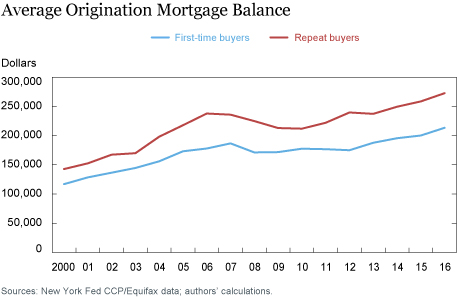
As in the case of the housing boom, the housing crash affected repeat buyers to a greater extent than first-time buyers. From its peak of $238,000 in 2006, the average origination mortgage balance for repeat buyers declined for three years, reaching its trough of $212,000 in 2009. For first-time buyers, the average origination mortgage balance peaked at $186,000 in 2007 and declined for just one year to $171,000 in 2008. Over the next four years, the average origination mortgage balance for first-time buyers changed very little. After 2012, as house prices recovered, the average origination mortgage balance for first-time buyers resumed its upward trend. Over the full period from 2000 to 2016, the average origination mortgage balance for first-time buyers rose by 84 percent as compared with 92 percent for repeat buyers. In 2016, the ratio of first-time to repeat buyer average origination mortgage balances was 78 percent, similar to its earlier 2007 value.
A second important factor determining a borrower’s ability (and cost) to obtain a mortgage to purchase a house is the buyer’s credit score. In our next chart, we compare the average credit scores of first-time buyers and repeat buyers. As expected, average credit scores for repeat buyers consistently exceed those of first-time buyers. In 2000, the average credit score for first-time buyers was 670 and for repeat buyers it was 705—a spread of 35 points. The credit quality of first-time and repeat buyers increased slightly from 2000 to 2003. As the housing boom intensified after 2003, the average credit score of first-time buyers declined slightly from 686 to 673, while for repeat buyers it was essentially unchanged. Starting in 2007 as house prices began to decline and mortgage defaults increased, the average credit quality of both first-time and repeat buyers resumed their upward trend. This continued until 2013 when the average credit score of first-time buyers reached 717, while for repeat buyers it reached 757. Over the next three years, the average credit quality of both types of buyers was relatively unchanged. Note that in 2016, the spread between the average credit scores was 37 points—essentially unchanged from 2000.
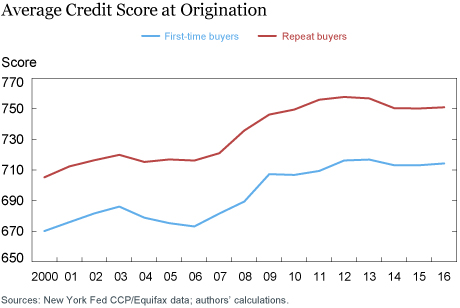
One area of growing concern is whether rising student loan debt may be crowding out homebuyers. This concern could be particularly relevant for first-time buyers. In the next chart, we show the average student loan debt for both types of buyers, conditional on the buyer having one or more student loans.
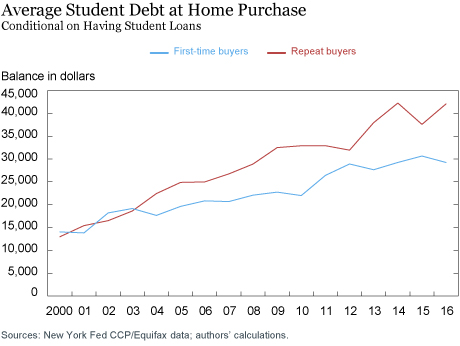
For buyers with student loans, in 2000 there was essentially no difference in the average size of these loans between first-time and repeat buyers. For both types of buyers, the conditional average student loan debt was around $14,000. This parity remained the case until 2003. From 2003 to 2010, the conditional average student loan debt grew faster for repeat buyers than for first-time buyers. By 2010, the gap between the two types of buyers had reached $11,000. Starting in 2010, the growth rate of student loan debt for first-time buyers picked up. As of 2016, the conditional average student loan debt for first-time buyers had reached $29,000, compared with $42,000 for repeat buyers—resulting in a gap of $13,000. For first-time buyers with student loans, the average balance from 2000 to 2016 roughly doubled, while for repeat buyers with student loans the average balance more than tripled. In our third post, we explore the question of whether higher student loan balances reduce the sustainability of homeownership for first-time buyers.
The combination of higher mortgage balances, higher student loan balances, and higher required credit scores could delay the transition of households from renting to owning. The next chart shows the average age of first-time and repeat buyers as of the year of the home purchase. In 2000, the average age for first-time buyers was 37.9 years, while for repeat buyers it was 44.7 years. Despite the factors discussed earlier, the average age of first-time buyers trended down over the entire period, reaching 35.4 years in 2016. In contrast, the average age of repeat buyers trended up over the period, reaching 47.5 years in 2016. The age distribution for both types of borrowers is right-skewed, resulting in average ages exceeding median ages. When we look at medians, we see that the median age of first-time buyers declined from 35 in 2000 to 32 in 2016, while the median age of repeat buyers increased from 43 in 2000 to 46 in 2016.
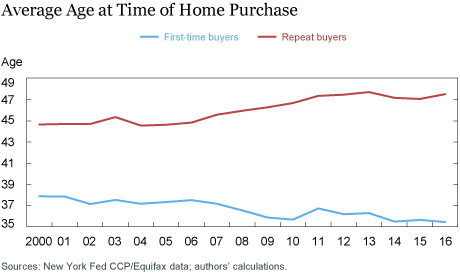
The final characteristic that we consider is the economic status of the local housing markets where first-time and repeat buyers are purchasing homes (see chart below). We use as our metric the average adjusted gross income in the zip code in 2010 as reported by the Internal Revenue Service. We do not observe the individual income of the borrowers, but instead use the average income of the borrower’s zip code as a proxy. If mortgage underwriting standards are easing, then this might show up as a decrease in the average zip code income. Note that a neighborhood’s average income is likely related, but is by no means identical, to broader measures of its socioeconomic status, including racial and ethnic composition, that have played a role in many discussions of mortgage lending.
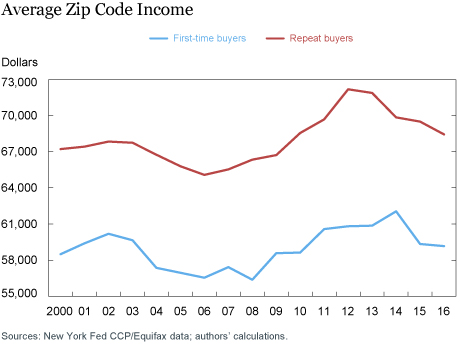
We see that the average zip code incomes for first-time and repeat buyers move roughly in a parallel manner. This result suggests that changes in access to mortgage credit over time have affected both types of buyers in a similar fashion. We also note that there is a roughly parallel movement between the pattern of rising and falling average incomes and the rising and falling credit scores in our second chart. However, as described earlier, average credit scores have been roughly unchanged since 2012, while average zip code incomes have been declining. This disparity suggests that other aspects of mortgage underwriting, such as minimum down payments, maximum debt-to-income ratios, and mortgage insurance premiums, may be responsible for the increased access to mortgage credit. In our third post, we will examine whether average zip code income is related to homeownership sustainability for first-time buyers.
In this post, we examined the characteristics of first-time buyers. We showed that average mortgage balances and student loan balances have been trending higher. At the same time, the average credit score of first-time buyers has also increased. However, the share of first-time buyers has been slowly increasing since 2014 despite a decline in the average zip code income for these buyers. This result suggests an easing in access to mortgage credit. It is important to note, though, that over the entire period of analysis the average age of first-time buyers has been trending lower.
Related Reading:
Lee, D., and J. Tracy. 2018. “Long-Term Outcomes of FHA First-Time Homebuyers.” Economic Policy Review 24, no. 3 (December): 145-65.
Disclaimer
The views expressed in this post are those of the authors and do not necessarily reflect the position of the Federal Reserve Bank of New York or the Federal Reserve System. Any errors or omissions are the responsibility of the authors.

Donghoon Lee is an officer in the Federal Reserve Bank of New York’s Research and Statistics Group.

Joseph Tracy is an executive vice president and senior advisor to the president of the Federal Reserve Bank of Dallas.
How to cite this blog post:
Donghoon Lee and Joseph Tracy, “Who’s on First? Characteristics of First-Time Buyers,” Federal Reserve Bank of New York Liberty Street Economics (blog), April 10, 2019, https://libertystreeteconomics.newyorkfed.org/2019/04/whos-on-first-characteristics-of-first-time-homebuyers.html.











 RSS Feed
RSS Feed Follow Liberty Street Economics
Follow Liberty Street Economics
We thank Yaw for his useful comments. Regarding the first comment, what we report in the post is the origination mortgage balance and not the home price. If the average loan-to-value ratio of mortgages was higher following the Great Recession, then a flat or rising mortgage balance for first-time buyers wouldn’t be inconsistent with falling home prices. We examined whether there was a difference in the share of first-time buyers and repeat buyers in bubble and non-bubble states and found that pre-Great Recession there was a higher share of repeat buyers in the bubble states compared to the post-Great Recession period. Regarding the second comment, student debt is positively correlated with income because larger student debt indicates a longer period of attending post-secondary education and a greater likelihood of obtaining a post-secondary degree (both of which are associated with higher income). At the same time, student debt has been increasing across age cohorts. Repeat buyers tend to have higher income and to be older than first-time buyers, which would have opposite effects on the amount of student debt they hold. The data indicate that the income effect is stronger than the age effect in this case resulting, on net, in higher levels of student debt for repeat buyers.
“Over the next four years, the average origination mortgage balance for first-time buyers changed very little.” This is very interesting, we have all assumed substantial negative price shocks (although with geographic variance) for all homes during the great recession, but disaggregating the data tells a different story. What would be interesting to know is whether there is geographic variation between repeat buyers and first time buyers. For example, if most of the repeat buyers were concentrated in Arizona, Florida, Nevada, California, etc. states that experienced significant negative price shocks then the results wouldn’t be very surprising. I find the student loan debt and age graphs interesting. Are repeat buyers going back to school for graduate degrees? They seem to be older and have worked for some years, so you would expect that their student loan debt should be lower than first time buyers. Or they could have borrowed more for undergraduate degrees. It would be interesting to know the differences in down payments (as a percentage of house price) between these two groups. First time buyers seem to be using FHA loans a lot.